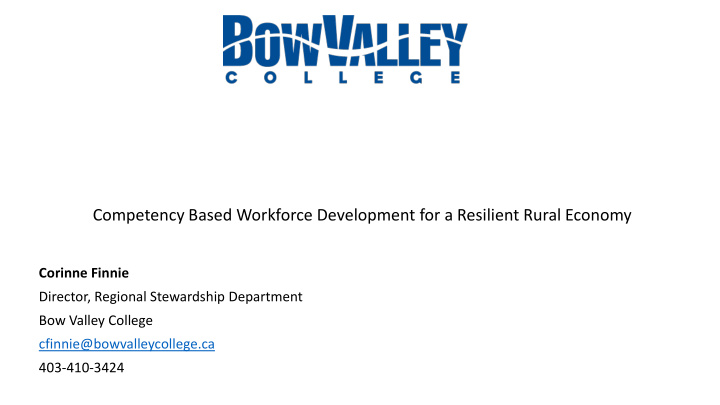



Competency Based Workforce Development for a Resilient Rural Economy Corinne Finnie Director, Regional Stewardship Department Bow Valley College cfinnie@bowvalleycollege.ca 403-410-3424
Vision To be an innovative world-class college, rooted in communities, enabling people to Learn a better living and Live a better life .
14,000 learners Certificate, diplomas, foundational learning, upgrading programs Credit and non-credit instruction: full time, part-time, traditional, synchronous, and online Mandate Bow Valley College is a public, board governed college operating as a comprehensive community institution under the Post-secondary Learning Act of Alberta.
Alb lberta Post-secondary In Institution Coll ollaborative Mod odel Structure 26 Post-secondary Institutions in Alberta 5 Universities 2 Polytechnics 8 Niche and/or Faith-based institutions 11 Comprehensive Community Colleges (CCI) in Alberta with Regional Stewardship funding to fulfill government mandate
Bow Valley College Region 44 communities 3 Indigenous reserve land Population = 250,000
44 Communities Treaty 7 Nations 250,000 population Infrastructure Investments: • Airdrie • Cochrane • Banff • Canmore • Strathmore • Okotoks • High River
Bow Valley College Increasing Access to Higher Education Opportunities in Rural Communities in the Calgary Region
Bow Valley College Needs Assessment Social Vitality Economic Diversification Community Development Entrepreneurship Lifelong Learning Pathways Industry Partnerships Specific training Local skilled needs of labour community requirements Competency Based Training Opportunity Infrastructure Technology Delivery Model Sustainability Model for Viable Programming in Communities, C. Finnie, Bow Valley College, 2015
Labour Force Segments – Alberta, Canada Newcomers Mature Workers Re-entering Workforce 55 + y.o. Prime Working Emergent Youth Years 25 – 54 y.o. 15 – 24 y.o. Rural Workforce Development: Assessing Employer Needs & Improving Access to Training Presentation, 2012, C.Finnie
Labour Force Overview - Alberta 31.0% 28.0% 23.0% 10.4% 7.6% 0 - 14 15 - 24 25 - 54 55 - 64 65 and over Focus on Geography Series - Alberta, 2011 Census, Statistics Canada
Programmin ing Opportunity Sc Scan Target Training Segment Competency Based Skills Delivery Tuition Development
Example: Prime Working Years Competency Based Skills Development “Reorients the education process toward demonstrated mastery and application of knowledge and skills in the real world” Pivoting Transferable Skills Emerging or High Demand Industries Environment High Technology ie. Agriculture Health Care Logistics/Transportation Information Technology Johnstone, S.M. and L. Soares . “Principles for Developing Competency - Based Education Programs.” Change, March -April 2014.
Transferable Skills Pivoting to Emerging Industries High Tech Green Tech Inland Port
Competency Based Transferable Skills Development Oil and Gas Industry Pivot into Growing and Emerging Industries Soft Skills Computer Skills Conflict resolution and management Software Problem solving Technology Professionalism Employability skills Other Technical Skills Confidence Business Writing Assertiveness Intercultural Communication Entrepreneurial Mindset Public Speaking Change Management Communication Coaching, Influencing, Feedback Oil and Gas Survey, Regional Stewardship Department, 2016.
Entrepreneurial l Min indset What barrier/issue are we trying to solve? Solutions Focused Mindset Who needs to be at the table to fully discuss opportunities? Collaborative Mindset What are the long term outcomes, activities, resources, etc to get there? Action Mindset How will we measure success? Accountability Mindset Entrepreneurial Mindset in Higher Education, Belize TVET System Presentation, 2016, C.Finnie
Workforce Development Top Training Needs, By Business Size Micro (3 – 9 employees) “Professional development Communicating Effectively allows employees to see the Improving Employee Performance/Soft Skills bigger picture of the business Social Media Marketing and corporate vision. Though an understanding of how the Small and Medium (10 – 99 employees) business works, trained Improving Employee Performance/Soft Skills employees can expand their Communicating Effectively potential in the company Management and Leadership itself.” Large ( 100 + employees) Large business manager Improving Employee Performance/Soft Skills Coaching Communicating Effectively Rural Workforce Development: Assessing Employer Needs & Improving Access to Training Presentation, 2012, C.Finnie
Funding Opportunities for Tuition Can’t find workers with the skills you need? Consider training new or current employees through the Canada-Alberta Job Grant and get 2/3 of the direct training cost reimbursed up to $10,000 per person. This employer driven program allows employers to decide on the type of training, who gets trained, and which eligible third- party trainer delivers the training. Find application forms and terms and conditions at www.AlbertaCanada.com/jobgrant.
Economic Diversification through Workforce Development Initiative Oil and Gas Talent Pool Emerging or High Skills Assessment Demand Sectors Entrepreneurial Development of Skills Transferable Skills
Questions an and Di Discussion Corinne Finnie Director, Regional Stewardship Department Bow Valley College cfinnie@bowvalleycollege.ca 403-410-3424
Recommend
More recommend